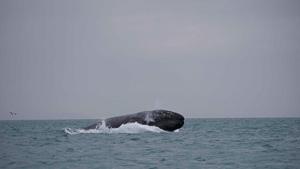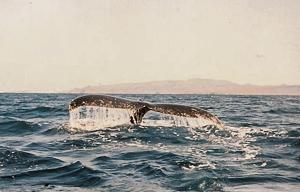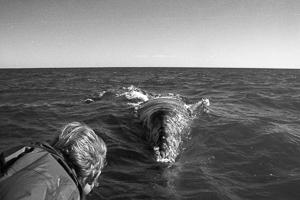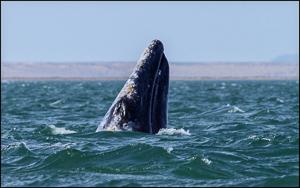

Around 1855, after first sealing in California and whaling in Magdalena Bay, Baja, Charles Scammon, a captain from Maine turned his attention to San Ignacio Bay. By 1859-60 the grays had been all but eliminated. San Ignacio, now a World Heritage site and UNESCO-declared refuge zone, was once witness to an unspeakable desecration of its fragile wildlife. This history makes the pilgrimage there all the more remarkable.
A sprouting marvel explodes from the back of gray giants, first from a mother then from a calf, and suddenly one realizes the waters are alive with mind; a depth charge of consciousness is set off within your immediate reality. As you enter the sphere of cognizance and heart shared by humans and animals alike, for the first time you understand that humans are not alone. Some come to your boat and you reach out, as did our 7-year-old Lysander, yearning to retrieve a part of their essentiality. You have been baptized. They allow you, encourage you even, to reach out because you need to do so and they can sense it. Otherwise, our humanity, our very inhumanity, would overwhelm us and we would lose contact with one of the very great truths of existence, that an Indra's net of sentience connects us with the other and that the other is, in some ineffable way, trying to save us from our too overbearing selves. Just maybe.

What if this species were actually telling us something much deeper than what we normally think they can communicate? That these whales could have gone extinct makes the case for their outreach all the more compelling. At the height of factory whaling, their numbers plummeted to only a few hundred. Given a reprieve, their population numbers started bouncing back, and now the world has more than 20,000 of them. Never the less, we could have caused their extinction and with it, the loss of perhaps the most rarefied human-non-human ritual on the planet. For through this ritual, a symphony is extended to us when the whales breach, come up to a panga, stick their massive heads out of the water and eye the human experiment. Some whales stay long enough to allow us that extension of the hand, which says that deep down in the central core of time and memory, we are all the same. They know our kind and our unkindness and what we are capable of, and yet still they come. Through this act of commiseration, compassion for the havoc we represent to this life force, the whales are telling us something critical for our sanity and survival. They are saying, "We know who you are and what you have been. You have been forgiven... learn now who we are."
With the gray whales of Baja, humanity is being given an ongoing reprieve, like a prayer, an act of grace that is trying to heal history and to forge a new destiny. The whales as agents of creation have never been aggressors to our kind. They are messengers of the only true reason for being: to be coherent with Creation and to honor it. If, as we believe, we are the only species to have been given the gift of reason, our superiority is being challenged in Baja. The whales are consonant with the world and they are telling us to be the same.

Are we sure, in our short evolutionary history, that we are truly sentient? What the whales could be doing is demonstrating the act of exchanging one's mind for that of another. It is one of the central practices of higher adepts in Buddhism. They have seen our lower selves and felt the full force of our madness. They experienced firsthand the butchery and savagery of our kind and they are telling us we can change. That we must change.
The ritual of Baja is a covenant unlike any other on earth. If we are willing to meet these spectacular beings half way, a part of our conscience changes and something ineffable in the soul is altered for all time. We are being given a chance to rethink the human equation. Nothing we can construct, no cultural artifact, no mathematical equation, no invention can match the beauty and power of coming together with another mind that evolved tens of millions of years ago. While we seek alien life forms in our solar system or light years away, there is a being, the friendliest species of whale on earth, that is urging us to shed the skin of terror, suspicion and slaughter we have been raised on. To be fully human, means to touch the tactile soul of the other and to exult in an ethic and esthetic of equality. If we meet them half way, their mindful exultation in the world should provide a lesson to our supposed superiority, now more than ever.

The US Navy's sonar blasts in the Pacific and the Bahamas have caused irreparable damage to several species of whales, many of which have been found dead on the world's beaches. In January 2009, 45 sperm whales were marooned in Tasmania. All but seven died. In March 2009, about 90 pilot whales and bottlenose dolphins died in Hamelin bay in Australia. In January 2005, 33 pilot whales beached themselves on Oregon's coast. The sonar of mayhem, whether for military exercises or to find new sources of oil to run an effete civilization, is literally deafening the world. Are we becoming deaf to the song of the earth? Are we becoming existentially autistic? The war of humanity against the other must stop once and for all, if we are to retain a semblance of sanity.
Native peoples all over the world, perhaps best evinced in such testimonials as Whalerider, have honored the other beings as incarnations, as emanations of the larger psyche of Creation. It is a simple imperative: change the legacy of our technologically overbearing civilization in the next few years, or we won't survive. In the sacred texts, we were supposed to be the stewards of life. Today, that is our most urgent task. The whales run deeper into our subconscious than perhaps any other group of beings. The havoc we have visited upon them has to be transformed into a conscious reverence for the irreplaceable. That is what makes the whales of Baja such a miracle: They are showing us the way.
Photos are used through Flickr Creative Commons Attribution License 2.0 Generic. Copyright information for the photos are as follows: (1) Close Encounter, photo courtesy of Charlie Stinchcomb; (2)Whale Tale, photo courtesy of Paul Downey; (3) Grey Whales in San Ignacio Lagoon, photo courtesy of Marc Uhlig; (4) Spy Hop with Blowhole, photo courtesy of Joe McKenna.